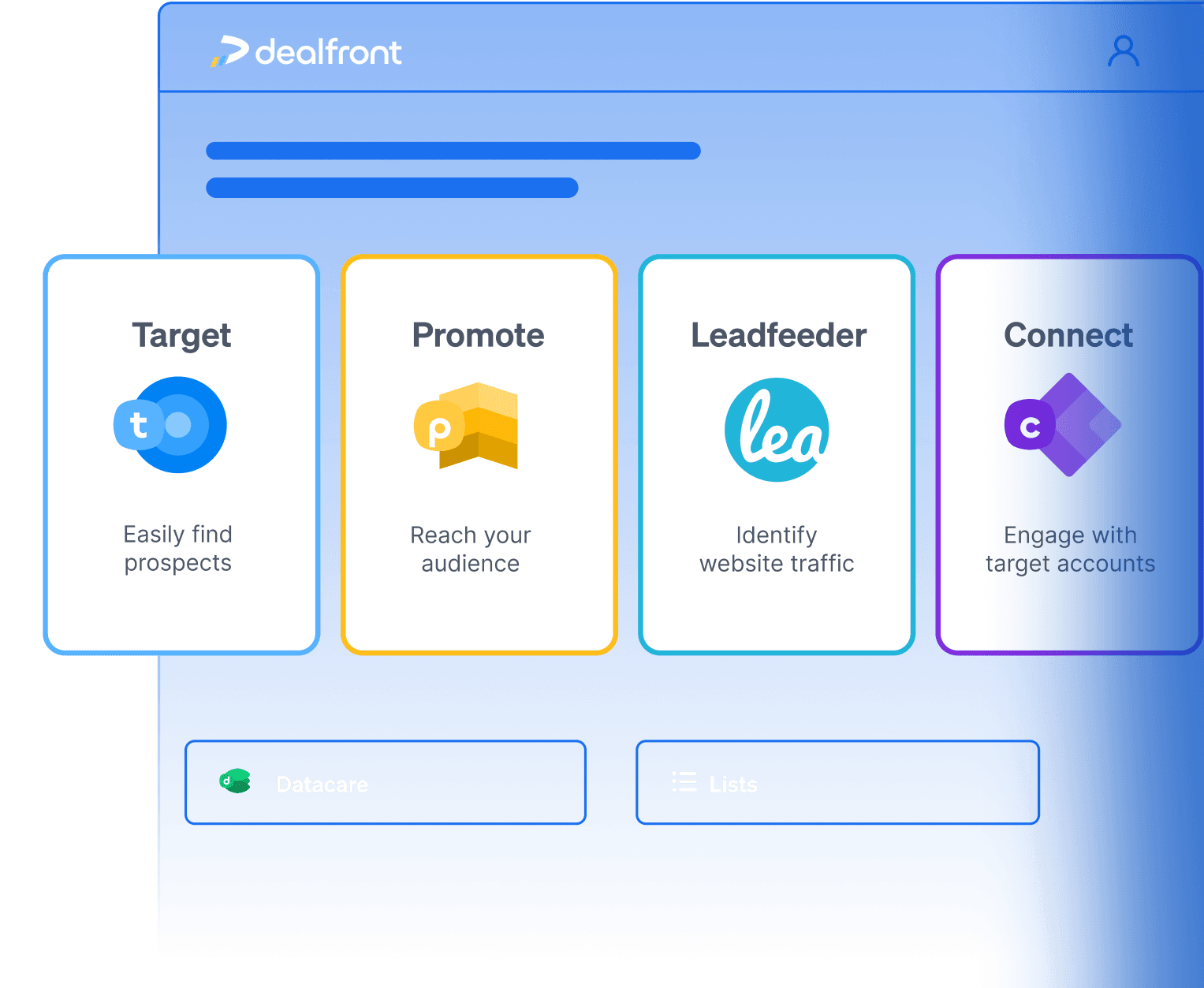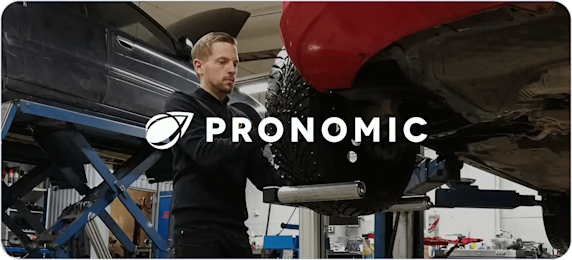How to Create Laser Focused Audience Segments to Increase Conversions
Erwartete Ergebnisse
Structure your targeting approach – Improve efficiency and maximize ROI.
Engage the full ICP target group – B2B deals involve multiple stakeholders.
Refine with data – Use firmographic, technographic, and behavioral insights.

Ever heard the phrase, "If you try to please everyone, you end up pleasing no one"? The same applies to marketing and sales. Cast your net too wide, and you’ll reel in unqualified leads, wasting budget and resources. Get too specific, and you might miss hidden opportunities.
So, what’s the answer? Precision targeting—balancing reach and relevance. Too often, marketing teams focus on quantity over quality, hoping a fraction of leads will convert. But as the old sales adage goes, "It’s not about working harder; it’s about working smarter." According to Gartner, the average B2B buying process involves six to ten decision-makers, each with their own concerns, biases, and authority. If you’re only speaking to the final decision-maker, you’re missing the real influencers shaping the conversation long before a deal is on the table.
Take, for example, a fast-growing SaaS company that struggled with their sales pipeline. They had no trouble generating leads, but their conversion rates were dismal. Why? Their targeting was based on broad firmographics such as,"mid-sized companies in tech", without considering job roles, pain points, or buying signals. After refining their approach using intent data and behavioral insights, they cut their customer acquisition cost by 40% and doubled their SQL-to-close rate. And the difference was simple: they started engaging the right people at the right time with the right message.
In B2B selling, a one-size-fits-all approach no longer works. Relying on outdated targeting strategies leads to ballooning costs, disengaged prospects, and lost revenue. But using firmographic, technographic, and real-time intent data allows businesses to:
Pinpoint high-value accounts that are actively looking for solutions.
Identify key stakeholders within the buying committee.
Deliver personalized messaging that resonates at every stage of the buyer’s journey.
Precision targeting isn’t just about improving conversion rates, it’s about optimizing resources and maximizing ROI. B2B companies shouldn’t just focus on chasing more leads, but should be more concerned with whether they’re chasing the right leads. By aligning marketing and sales around data-driven targeting, they can create predictable and scalable growth.
In the following sections of this Play, we’ll break down how you can apply this approach using Dealfront, with real-world use cases, a step-by-step workflow, and actionable insights. So, whether you're looking to reduce wasted ad spend, boost engagement, or accelerate sales cycles, precision targeting is the foundation for long-term success.
How can precision targeting solve your B2B challenges?
Many B2B teams struggle with targeting for a number of reasons such as, spending too much on broad audiences, missing key stakeholders, or reaching out to companies at the wrong time. Let’s explore three common challenges and how precision targeting helps businesses overcome them.
Scale without wasting budget
One of the biggest inefficiencies in marketing is spending budget on audiences that don’t convert. Many companies start with broad targeting, casting a wide net to generate leads. But if those leads don’t match their ideal customer profile, sales teams waste time qualifying unfit prospects, and marketing struggles with low conversion rates.
A more effective approach is to refine targeting based on firmographic data and make sure you’re focusing on companies that match the right size, industry, and revenue criteria. But static firmographics alone don’t tell the full story. Companies that look good on paper may not actually be in the market for a solution. By layering in intent signals such as hiring trends, technology adoption, or recent funding, businesses can ensure they’re reaching not just the right type of company, but the ones most likely to convert. This helps optimize ad spend and improve pipeline quality.
Reach the full ICP target group
In B2B sales, an average of 6–9 stakeholders are involved in the buying process, yet many companies focus their efforts on just one decision-maker. Even if outreach reaches the right contact, deals can stall when other key stakeholders aren’t engaged. A more strategic approach is to identify and focus on the full ICP target group, ensuring that all decision-makers and influencers receive relevant messaging throughout the whole pipeline generation process.
By using segmentation capabilities, companies can go beyond just the final decision-maker and proactively engage all relevant stakeholders, such as department heads, procurement teams, and technical evaluators. Ultimately, this leads to smoother decision-making, fewer roadblocks, and shorter sales cycles.
Identify companies ready to buy
One of the biggest inefficiencies in B2B sales is reaching out to companies at the wrong time. Too many teams rely on cold outreach to accounts that have no immediate need, leading to low engagement and long sales cycles. But here’s the reality: buyers control how and when they engage, not us. We often get so caught up in building funnels that we forget our job is to meet buyers where they are, when they’re actually ready to have a conversation.
A better approach is to prioritize outreach based on real-time signals that indicate when a company is actively in the market for a solution. Key indicators include:
Hiring activity in relevant roles (e.g., sales, marketing, procurement)
Recent funding or expansion (suggesting new budget availability)
Website visits or product interest (showing active research)
By using these intent signals, teams can focus their efforts on companies already looking for a solution—resulting in higher response rates, better conversations, and more efficient sales cycles.
This highlights a common truth in B2B marketing and sales: success isn’t about reaching more companies—it’s about engaging the right accounts, at the right time, with the right message. Your team shouldn’t have to force its way into conversations; they should be aligning with buyers when the interest is already there.
By adopting data-driven targeting strategies, businesses can:
Reduce wasted ad spend by focusing only on high-potential accounts
Engage all key stakeholders to prevent deal roadblocks
Time their outreach effectively to maximize conversions
Next, we’ll explore how Dealfront’s targeting workflow makes this level of precision possible.
Dealfront targeting: From audience to closing deals
A well-defined targeting workflow ensures your marketing and sales teams work together efficiently. With Dealfront, the process looks like this:
Build your Total Addressable Market (TAM)
Start broad by defining your Ideal Customer Profile (ICP) using firmographic filters like industry, size, and location. Use Dealfront’s TAM Calculator to quickly assess market potential and identify high-value opportunities beyond the companies already on your radar. For a deeper dive, check out our Play on Total Addressable Market (TAM) to learn how to identify, refine and maximize your target market.
Refine your target audience with advanced segmentation
With over 100 segmentation filters, you can precisely narrow your audience using firmographic, technographic, and demographic data. Instead of focusing solely on the key decision-maker, identify the entire buying committee, including influencers who shape the purchasing process. By using real-time intent signals or sales triggers, you can engage companies at the perfect moment when they’re most likely to buy.
Activate your audience with multi-channel campaigns
Once you've refined your audience, it's time to put it to work. Advertise to your target accounts via LinkedIn, Google Ads, and Dealfront Promote. Once you've refined your audience, launch hyper-targeted campaigns that reach the right people at the right time. To keep marketing and sales aligned, track engagement in Leadfeeder, ensuring your teams can act on real-time insights and maximize conversions.
Convert leads with CRM integration
Seamlessly push high-intent prospects into your CRM, whether it’s Salesforce, HubSpot, or another platform, so your sales team can act fast. Automated alerts in Dealfront ensure reps are notified the moment key accounts show buying intent, allowing them to engage at the perfect time.
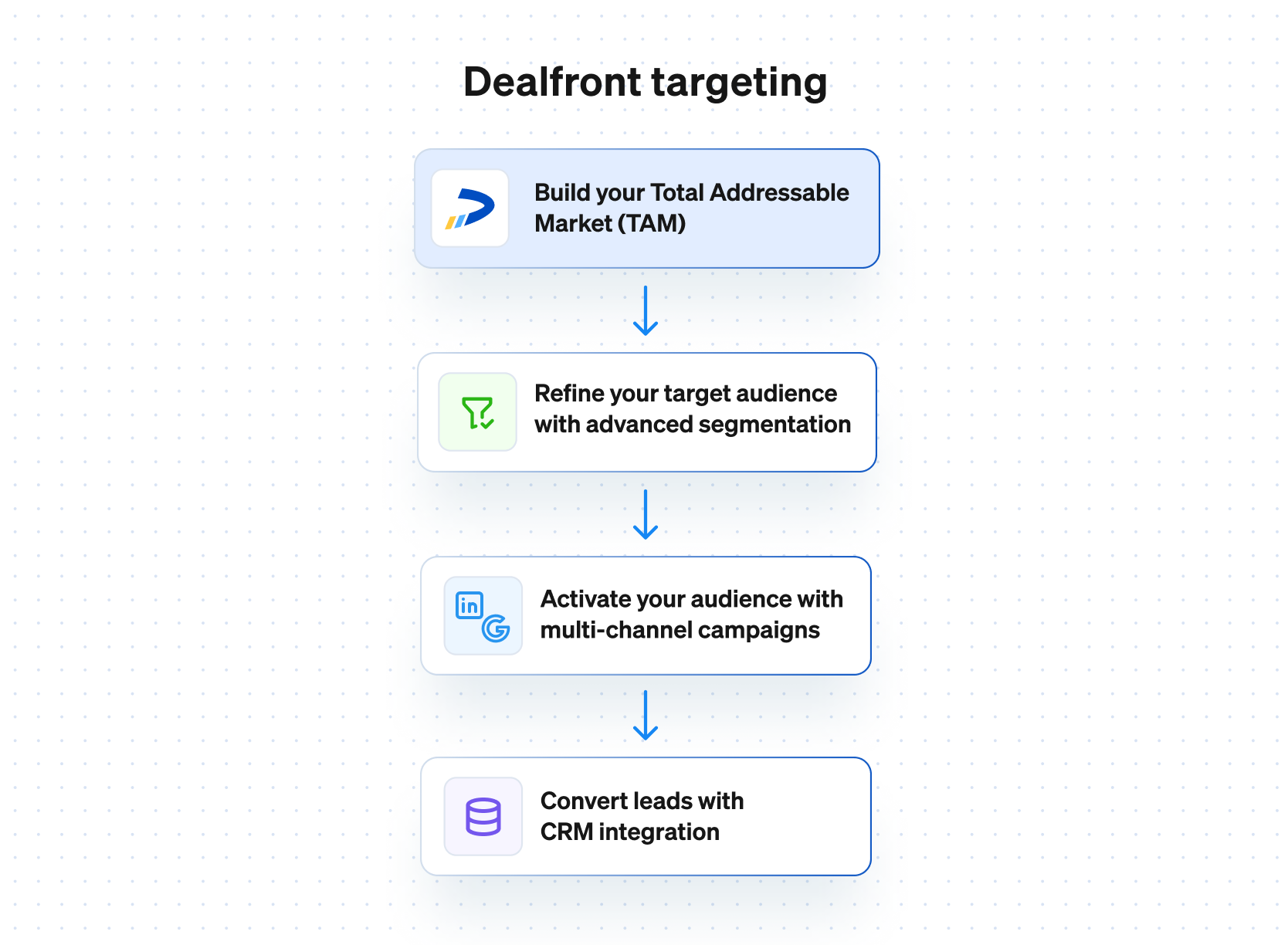
How to Build Laser-Focused Audience Segments in Dealfront
Step 1: Define your TAM with firmographic data
To define your target market, start by identifying who your potential customers are. Break down the broader market into specific segments based on common characteristics like industry, company size, and location. You can do this through customer profiling, market research, and analyzing data from your CRM (Customer Relationship Management) system. This approach helps you tailor your marketing strategies to meet the needs of different customer groups more effectively.
Start broad to capture all potential opportunities. Key firmographic filters include:
Industry & Sub-Industry: Use precise classifications like NACE codes to drill down into niche markets where your solution has the strongest fit.
Company Size: Target companies with a minimum number of employees (e.g., 100+), which often correlates with greater need and buying power.
Geographic Region: Focus on markets where your team can sell and support efficiently, such as regions with strong existing presence or local language coverage.
Growth Indicators: Look at signals like recent funding rounds or rapid growth to prioritize companies likely to be in a buying phase.
Example: A security training provider may focus on manufacturing firms in the DACH and Benelux regions within sectors like industrial machinery, automotive, or metal processing, each with 100+ employees.
Thijs Schutyser, Team Lead Growth New Business from Dealfront illustrated this by showing how applying location, company size, and NACE code filters via Dealfront Target resulted in a TAM of around 90,000 companies, a useful starting point for future segmentation.

Next step: Once your TAM is defined, break it down into manageable, high-priority segments to align with your team’s capacity and outreach goals.
Step 2: Narrow your audience with advanced segmentation
Before you can effectively target the right prospects, you need to understand the size of your market. Estimating your market size manually involves several steps, starting with defining your ideal customers: who they are, where they are, and how they buy. From there, you assess total market demand by researching industry reports or surveys to gauge the number of potential customers. Next, you determine your realistic market share by analyzing competitors, pricing strategies, and your unique value proposition. Finally, multiplying the number of potential customers by their estimated annual spend helps you calculate your Total Addressable Market (TAM).
While this method provides a rough estimate, tools like Dealfront Target streamline the process, delivering precise TAM calculations in seconds. But understanding your market size is just the first step. To maximize conversions, you need to go beyond broad market estimates and focus on the most relevant prospects. This is where advanced segmentation comes in, allowing you to narrow your audience based on firmographics, technographics, and buying signals, ensuring your outreach is as precise and effective as possible.
Use Advanced Segmentation Filters to Focus on High-Intent Accounts:
Technographics: Identify companies using specific technologies (e.g., target Salesforce users if your solution integrates with Salesforce).
Job Ads: Look for companies hiring for roles related to your solution—e.g., those advertising for safety training or cloud security roles signal an active need.
Website Content Signals: Use Dealfront’s website content filter to find companies displaying ISO certifications or industry-specific terminology that aligns with your product.
Expansion Signals: Prioritize companies undergoing growth, M&A, or investment—these changes often trigger new software, training, or infrastructure needs.
Website Visits (via Leadfeeder): Monitor which companies from your TAM are actively visiting your site, signaling potential interest. These are low-hanging fruit for Sales outreach.
Example: A cybersecurity company could narrow its audience to focus on enterprises with 500+ employees, that are:
Hiring for cloud security roles
Using Microsoft Azure
Undergoing rapid expansion
Visiting their website multiple times in the last month
This precision helps your Sales and Marketing teams align on high-value targets that are already showing signals of buying intent improving efficiency, engagement, and ultimately, conversion rates.

Next step: Use these advanced segmentation filters to build ICP-based segments and prioritize accounts for targeted outreach and campaign planning.
What next?
Now that you’ve built a high-quality target list, the next step is putting it to work. Precision targeting doesn’t just stop at identifying the right companies, it’s about engaging them effectively across the right channels. Here are three powerful ways to activate your audience and drive results:
1. LinkedIn targeting: engage decision-makers directly
With LinkedIn’s powerful ad platform, you can upload your target list and achieve over 90% audience match rates, ensuring your content reaches the right decision-makers. Use this to:
Run sponsored content ads to educate and nurture prospects with relevant insights.
Launch message ads (InMails) to start personalized conversations.
Test different CTAs to drive form fills, demo requests, or webinar sign-ups.
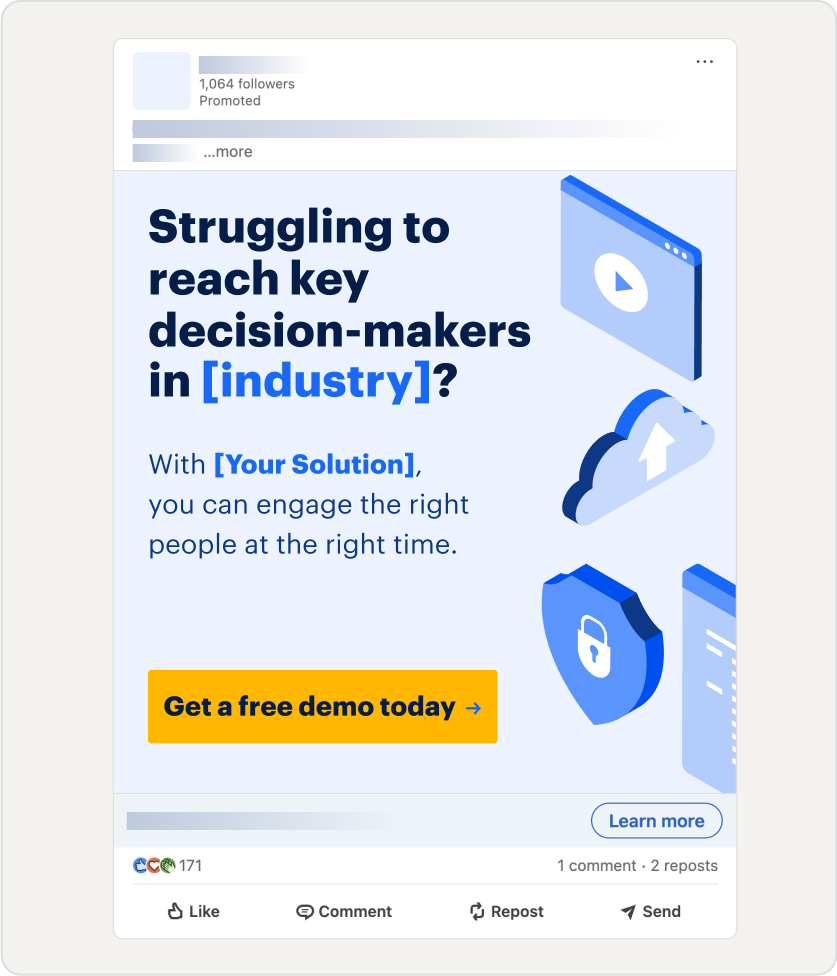
2. Google search ads: capture high-intent leads
Your target companies are actively searching for solutions like yours so make sure you appear at the top of search results. By syncing your audience list with Google Ads via the Leadfeeder Google Analytics integration, you can:
Prioritize high-intent keywords based on your audience’s search behavior.
Retarget past visitors who have already interacted with your website.
Measure campaign performance with real revenue impact, not just clicks.
3. Google display ads: stay top of mind
Programmatic display ads allow you to serve highly relevant, personalized ads to your target companies across millions of websites. Use this approach to:
Build brand awareness with engaging visuals and tailored messaging.
Retarget engaged prospects who have visited your site but haven’t converted.
Deliver account-based campaigns to key stakeholders within your target accounts.
By integrating your target list into these channels, you ensure your brand stays in front of the right people at the right time. Whether you’re driving awareness, generating leads, or accelerating deal velocity, precision targeting gives you the competitive edge you need.
Cheatsheet to write effective Google Search and Display ad copies
There are several established frameworks that can guide you in crafting effective copy for both Google Search and Display Ads. These frameworks provide structured approaches to creating compelling and persuasive advertising content. Here are some of the most widely recognized ones:
1. AIDA (Attention, Interest, Desire, Action):
This classic model focuses on capturing the audience's attention, building their interest, creating a desire for the product or service, and prompting them to take action. It's particularly effective in creating persuasive ad copy. For example, an ad could grab attention with a bold headline, pique interest with compelling benefits, create desire by highlighting positive outcomes, and finally, encourage action with a clear call-to-action.
Examples of AIDA Framework
Example 1: “From Chaos to Clarity”
Example 1: “From Chaos to Clarity”
Target audience: Sales teams struggling with disorganized lead and deal tracking.
Positioning: The CRM brings structure, visibility, and control to sales processes.
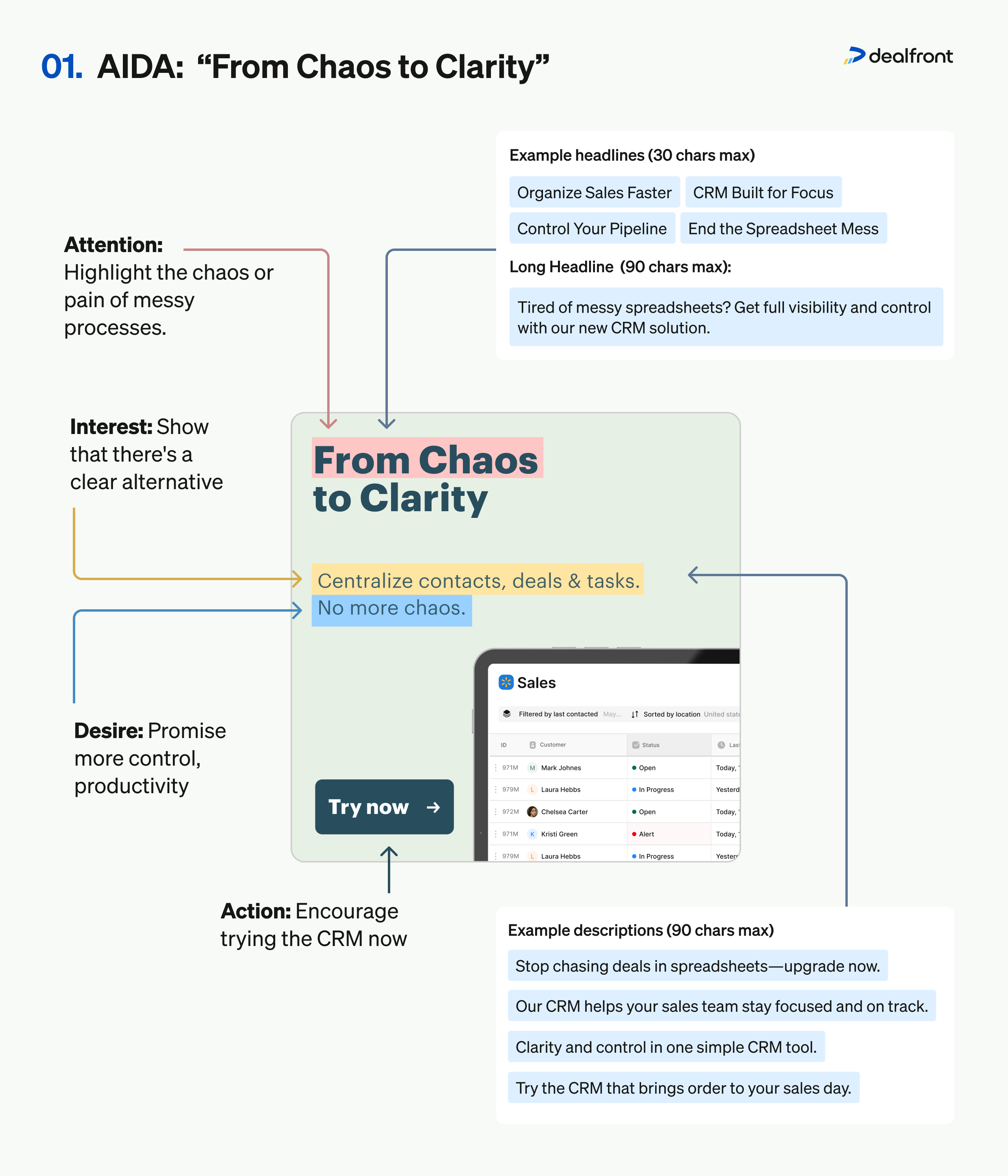
AIDA Framework Connection:
Attention: Highlight the chaos or pain of messy processes
Interest: Show that there's a clear alternative
Desire: Promise more control, productivity
Action: Encourage trying the CRM now
Example headlines (30 chars max):
Organize Sales Faster
From Chaos to Clarity
CRM Built for Focus
Control Your Pipeline
End the Spreadsheet Mess
Long Headline (90 chars max):
Tired of messy spreadsheets? Get full visibility and control with our new CRM solution.
Example descriptions (90 chars max):
Centralize contacts, deals & tasks. No more chaos.
Our CRM helps your sales team stay focused and on track.
Stop chasing deals in spreadsheets—upgrade now.
Clarity and control in one simple CRM tool.
Try the CRM that brings order to your sales day.
Example 2: “Grow Revenue, Not Headaches”
Example 2: “Grow Revenue, Not Headaches”
Target audience: Growth-minded SMBs and startups
Positioning: CRM as a revenue-boosting, stress-reducing growth tool
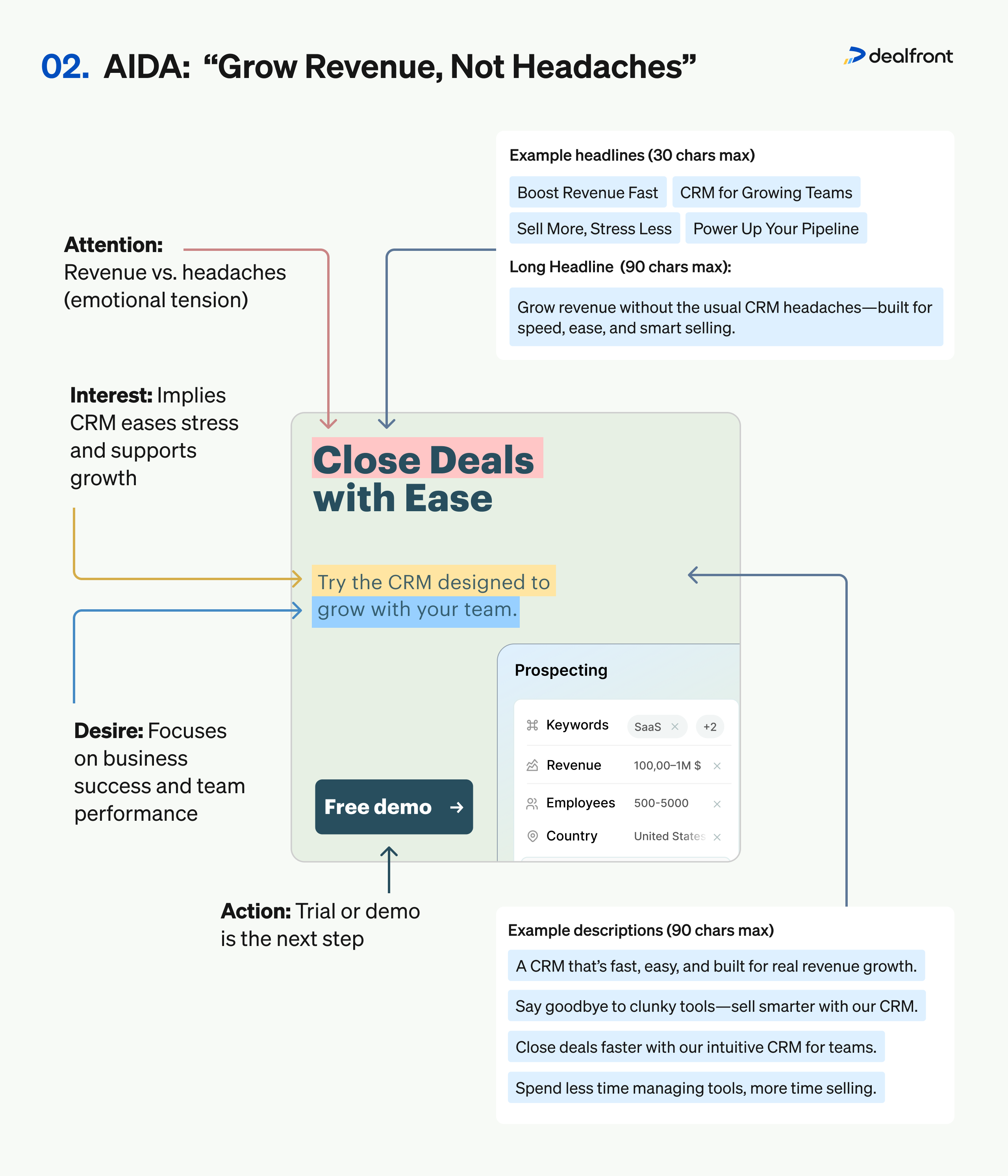
AIDA Framework Connection:
Attention: Revenue vs. headaches (emotional tension)
Interest: Implies CRM eases stress and supports growth
Desire: Focuses on business success and team performance
Action: Trial or demo is the next step
Example headlines (30 chars max):
Boost Revenue Fast
CRM for Growing Teams
Sell More, Stress Less
Power Up Your Pipeline
Close Deals with Ease
Long Headline (90 chars max):
Grow revenue without the usual CRM headaches—built for speed, ease, and smart selling.
Example descriptions (90 chars max):
A CRM that’s fast, easy, and built for real revenue growth.
Say goodbye to clunky tools—sell smarter with our CRM.
Close deals faster with our intuitive CRM for teams.
Spend less time managing tools, more time selling.
Try the CRM designed to grow with your team.
Example 3: “Your Team’s New Superpower”
Example 3: “Your Team’s New Superpower”
Target audience: Sales leaders and operations managers
Positioning: CRM as an empowerment tool for high-performance teams
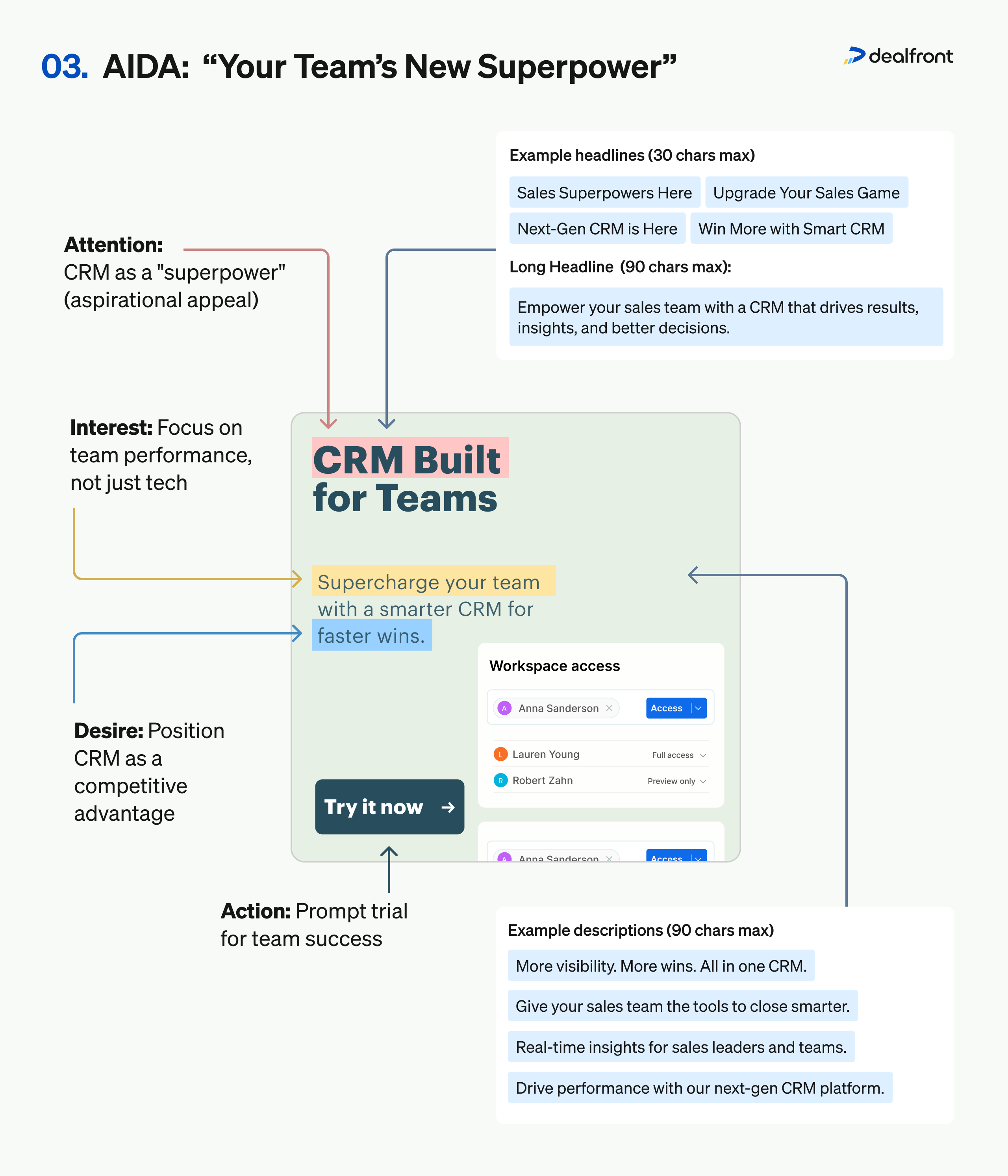
AIDA Framework Connection:
Attention: CRM as a "superpower" (aspirational appeal)
Interest: Focus on team performance, not just tech
Desire: Position CRM as a competitive advantage
Action: Prompt trial for team success
Example headlines (30 chars max):
Sales Superpowers Here
Upgrade Your Sales Game
Next-Gen CRM is Here
Win More with Smart CRM
CRM Built for Teams
Long Headline (90 chars max):
Empower your sales team with a CRM that drives results, insights, and better decisions.
Example descriptions (90 chars max):
Supercharge your team with a smarter CRM for faster wins.
More visibility. More wins. All in one CRM.
Give your sales team the tools to close smarter.
Real-time insights for sales leaders and teams.
Drive performance with our next-gen CRM platform.
2. Problem-Solution:
This framework involves identifying a common problem your target audience faces and presenting your product or service as the solution. It's straightforward and emphasizes the utility of the offering by highlighting how it effectively addresses the pain points and challenges that potential customers experience. This approach helps establish a connection with the audience by demonstrating that you understand their needs and have the means to fulfill them.
Examples of Problem-Solution Framework
Example 1
Example 1
Problem: Sales teams are stuck in spreadsheets, missing follow-ups and losing deals
Solution: A structured CRM that brings everything into one view
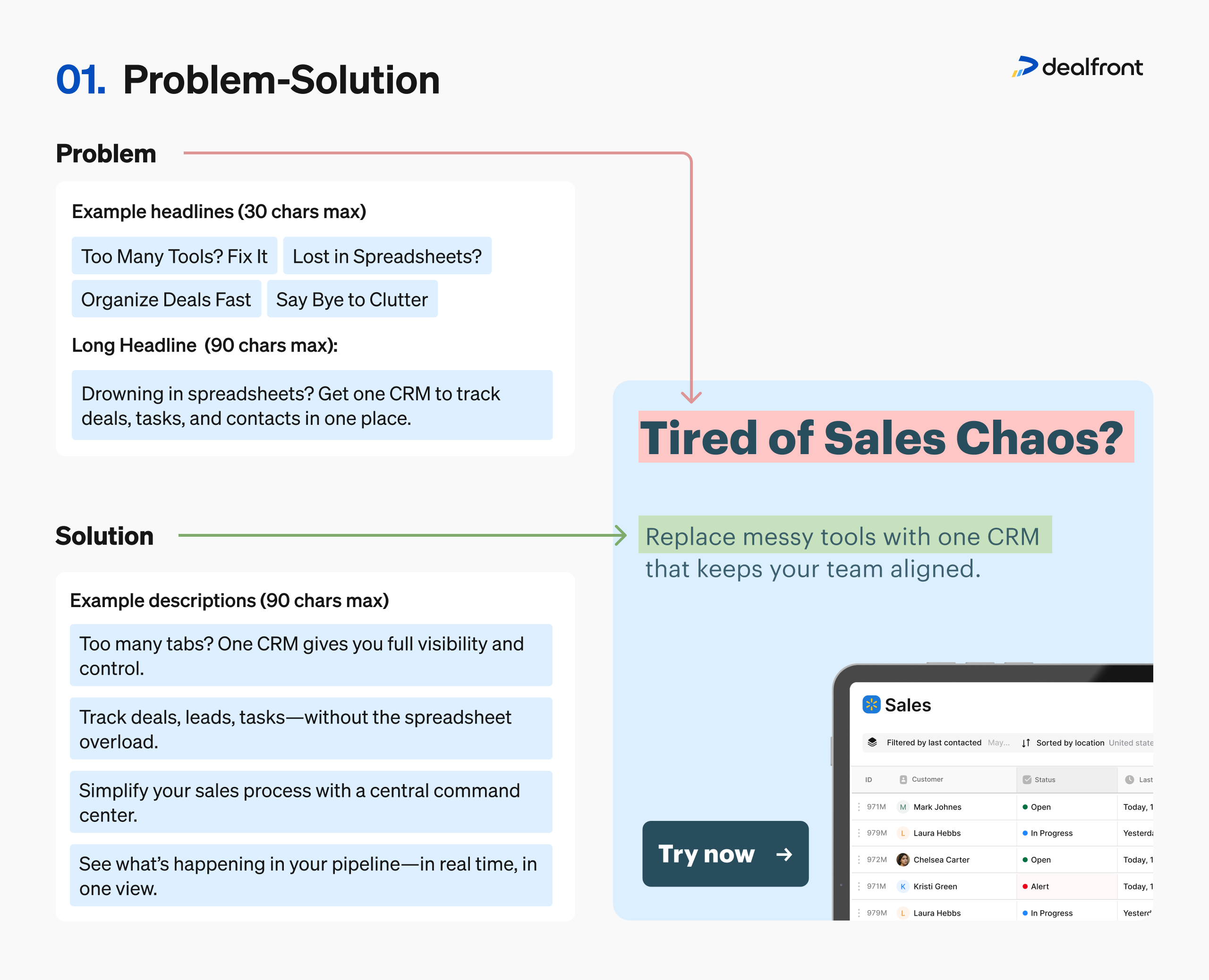
Example Headlines (≤30 characters):
Tired of Sales Chaos?
Too Many Tools? Fix It
Lost in Spreadsheets?
Organize Deals Fast
Say Bye to Clutter
Long Headline Template (≤90 characters):
Drowning in spreadsheets? Get one CRM to track deals, tasks, and contacts in one place.
Example descriptions (≤90 characters):
Replace messy tools with one CRM that keeps your team aligned.
Too many tabs? One CRM gives you full visibility and control.
Track deals, leads, tasks—without the spreadsheet overload.
Simplify your sales process with a central command center.
See what’s happening in your pipeline—in real time, in one view.
Example 2
Example 2
Problem: The current CRM is slowing your team and costing deals
Solution: A faster, cleaner experience that reps actually use
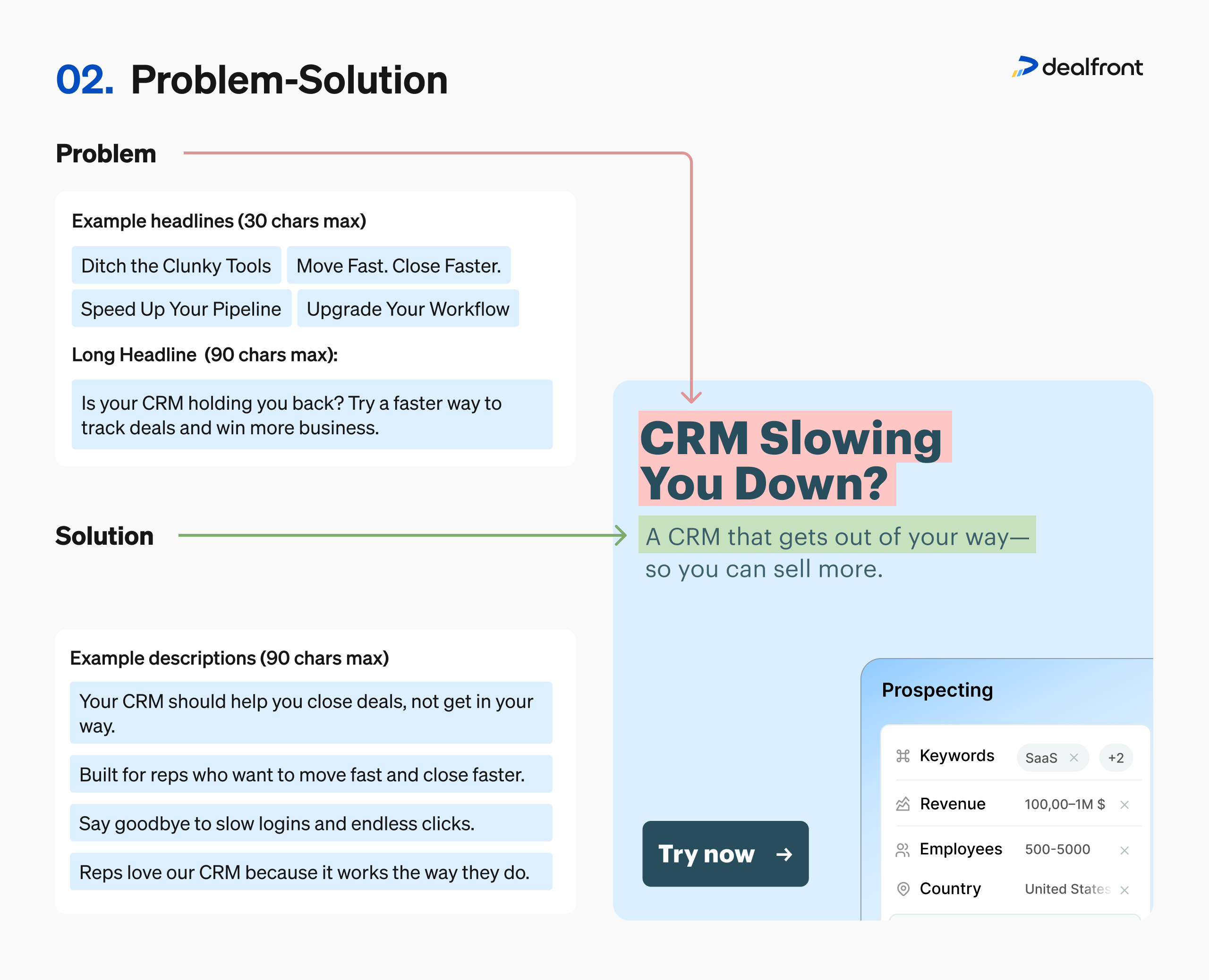
Example headlines (≤30 characters):
CRM Slowing You Down?
Ditch the Clunky Tools
Move Fast. Close Faster.
Speed Up Your Pipeline
Upgrade Your Workflow
Long Headline Template (≤90 characters):
Is your CRM holding you back? Try a faster way to track deals and win more business.
Example descriptions (≤90 characters):
Your CRM should help you close deals, not get in your way.
Built for reps who want to move fast and close faster.
A CRM that gets out of your way—so you can sell more.
Say goodbye to slow logins and endless clicks.
Reps love our CRM because it works the way they do.
Example 3
Example 3
Problem: Deals fall through the cracks due to lack of follow-up
Solution: Smart CRM that tracks activity and reminds you to act
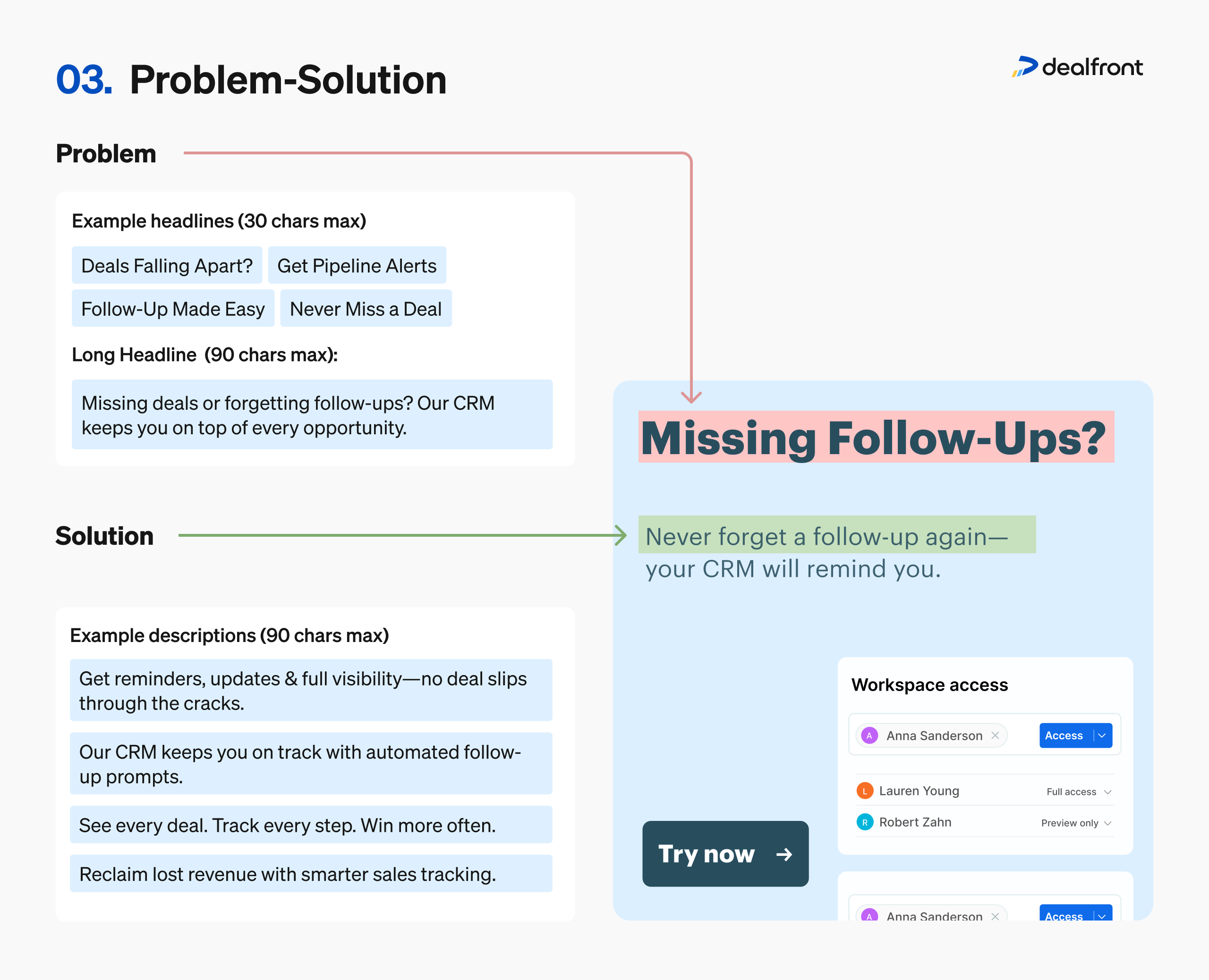
Example headlines (≤30 characters):
Missing Follow-Ups?
Deals Falling Apart?
Get Pipeline Alerts
Follow-Up Made Easy
Never Miss a Deal
Long Headline Template (≤90 characters):
Missing deals or forgetting follow-ups? Our CRM keeps you on top of every opportunity.
Example descriptions (≤90 characters):
Get reminders, updates & full visibility—no deal slips through the cracks.
Our CRM keeps you on track with automated follow-up prompts.
See every deal. Track every step. Win more often.
Reclaim lost revenue with smarter sales tracking.
Never forget a follow-up again—your CRM will remind you.
3. Before-After-Bridge (BAB):
This approach paints a picture of the audience's world before and after using your product or service, effectively highlighting the transformation and emphasizing the benefits and value it brings. The 'bridge' then explains how your offering facilitates this change , showcasing how your product or service is the key to achieving the desired outcome. This persuasion technique works by clearly illustrating the contrast between the current situation and the improved reality after adopting the solution, making the benefits more tangible and compelling.
Understanding and applying these frameworks can significantly enhance the effectiveness of your advertising efforts across different platforms. By providing a clear structure and persuasive elements, these frameworks help you create compelling ad copy that resonates with your target audience and drives them towards taking action, ultimately improving the overall performance of your campaigns.
Examples of Before-After-Bridge (BAB) Frameworks
Example 1
Example 1
Before: Lost deals, disjointed tools, no oversight
After: Full pipeline visibility and control
Bridge: A CRM that keeps everything in one place
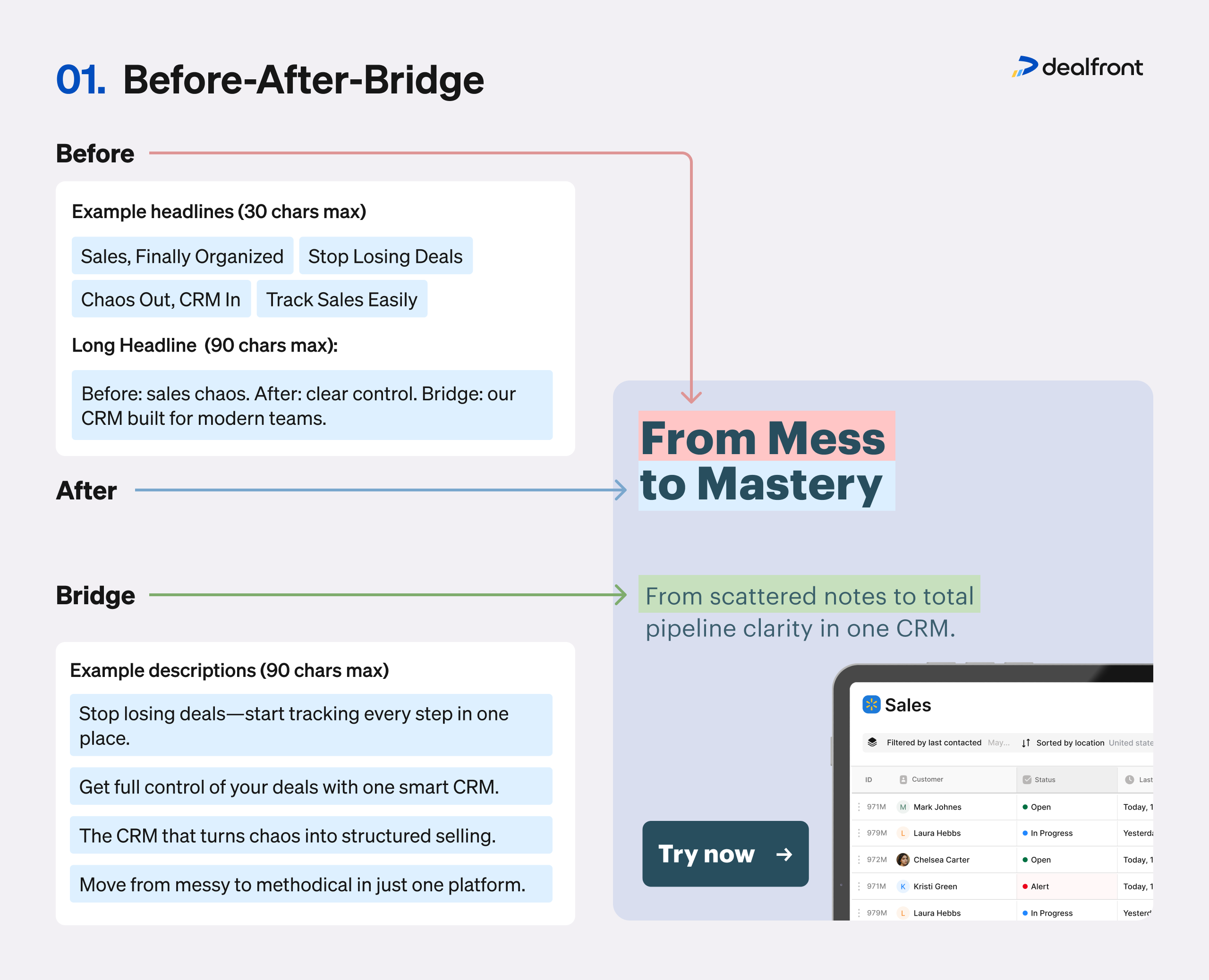
Example headlines (≤30 characters):
From Mess to Mastery
Sales, Finally Organized
Stop Losing Deals
Chaos Out, CRM In
Track Sales Easily
Long Headline Template (≤90 characters):
Before: sales chaos. After: clear control. Bridge: our CRM built for modern teams.
Example descriptions (≤90 characters):
Stop losing deals—start tracking every step in one place.
From scattered notes to total pipeline clarity in one CRM.
Get full control of your deals with one smart CRM.
The CRM that turns chaos into structured selling.
Move from messy to methodical in just one platform.
Example 2
Example 2
Before: Frustrating CRM experience, low adoption
After: Reps fly through tasks with ease
Bridge: A CRM built for speed and usability
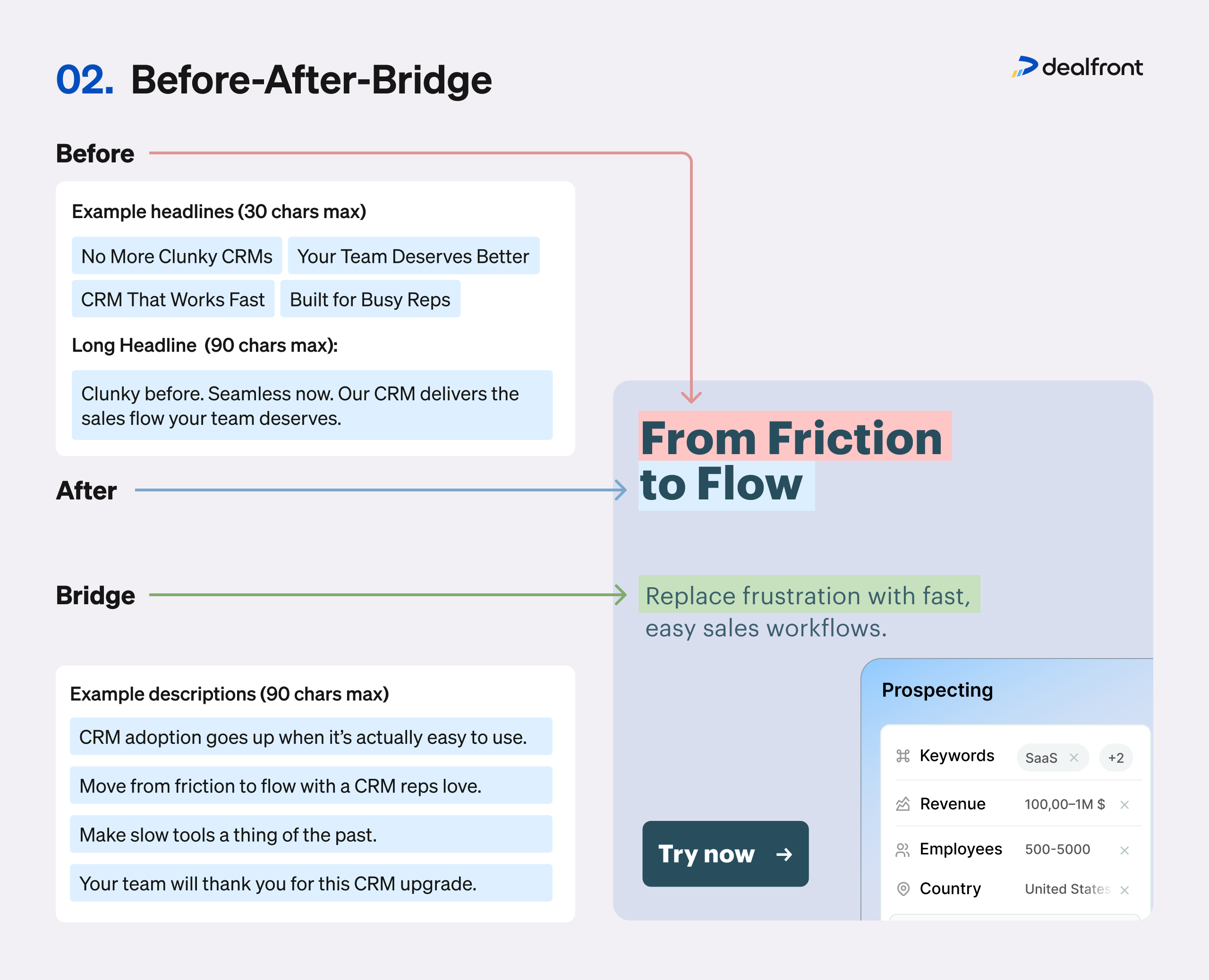
Example headlines (≤30 characters):
No More Clunky CRMs
From Friction to Flow
Your Team Deserves Better
CRM That Works Fast
Built for Busy Reps
Long Headline Template (≤90 characters):
Clunky before. Seamless now. Our CRM delivers the sales flow your team deserves.
Example descriptions (≤90 characters):
Replace frustration with fast, easy sales workflows.
CRM adoption goes up when it’s actually easy to use.
Move from friction to flow with a CRM reps love.
Make slow tools a thing of the past.
Your team will thank you for this CRM upgrade.
Example 3
Example 3
Before: Deals go cold due to forgotten tasks
After: Consistent, timely engagement
Bridge: A CRM that reminds and nudges reps at the right time
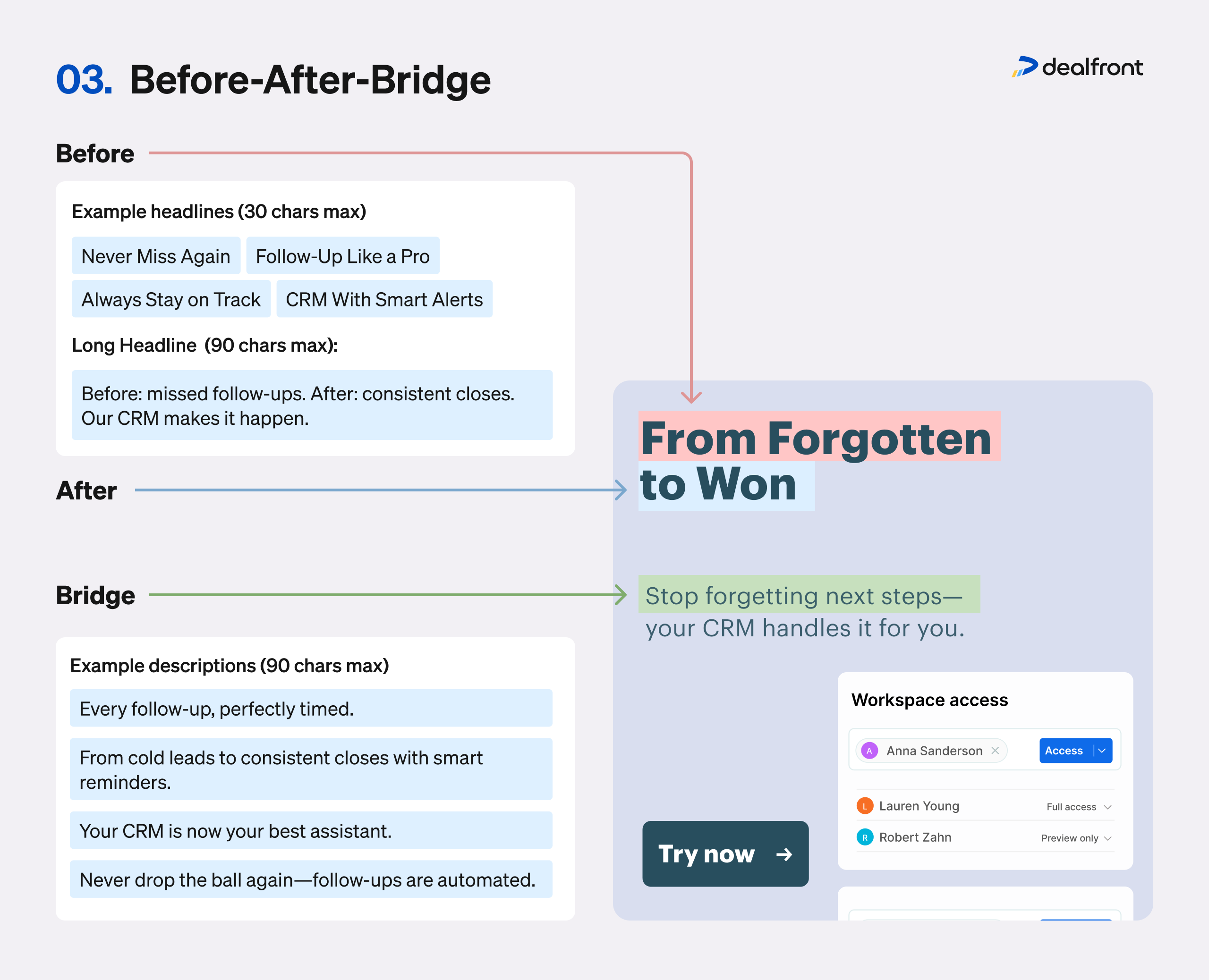
Example headlines (≤30 characters):
Never Miss Again
From Forgotten to Won
Follow-Up Like a Pro
Always Stay on Track
CRM With Smart Alerts
Long Headline Template (≤90 characters):
Before: missed follow-ups. After: consistent closes. Our CRM makes it happen.
Example descriptions (≤90 characters):
Stop forgetting next steps—your CRM handles it for you.
Every follow-up, perfectly timed.
From cold leads to consistent closes with smart reminders.
Your CRM is now your best assistant.
Never drop the ball again—follow-ups are automated.
Expected results
When done right, precision targeting drives measurable business outcomes. By eliminating unqualified accounts, you reduce wasted ad spend and lower your Cost per Qualified Lead (CPQL). Targeting the right audience ensures your outreach reaches decision-makers who care, leading to higher engagement and conversion rates. Timing also plays a critical role—by identifying companies actively searching for a solution, you accelerate sales cycles and close deals faster.
Precision targeting isn’t about making your audience smaller—it’s about making it smarter. With the right accounts, the right timing, and the right message, you maximize efficiency and drive better results.
Setzen Sie Erkenntnisse in Taten um
